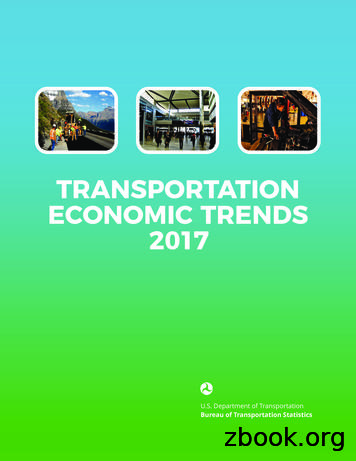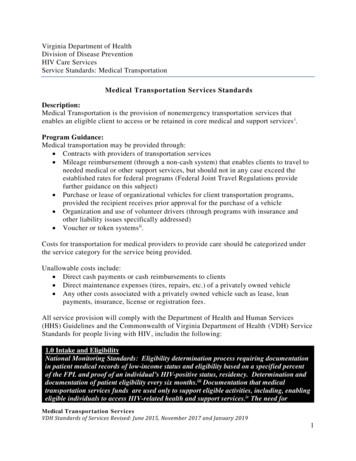U.S. Department Of Transportation, Federal Highway . - ARPA-E
U.S. Department of Transportation, Federal Highway AdministrationShaping the Future of American Mobility:Connected Automated Vehicles (CAV)Taylor Lochrane, Ph.D.Office of Operations Research and Development
Today’s Transportation ChallengesSafety 35,092 highway deaths in 20151 6.3 million crashes in 20151 A leading cause of death for ages 1-442Mobility3 6.9 billion hours of travel delay 160 billion cost of urban congestionEnvironment3 3.1 billion gallons of wasted fuel 60 billion lbs of additional CO2Data Sources:1DOT HS 812 318, Traffic Safety Facts, National Highway Traffic Safety Administration (August 2016)210 Leading Causes of Death by Age Group, United States – 2014, Centers for Disease Control and Prevention32015 Urban Mobility Scorecard, Texas A&M Transportation Institute and INRIX (August 2015)
U.S. DOT Connected Vehicle (CV)Research Program Research Program Major Deployment Efforts Multimodal: ITS JPO, NHTSA, FMSCA, FTA, and FRAKey Areas: Safety, Mobility, and EnvironmentConnected Vehicles: Vehicle-to-Vehicle (V2V) andVehicle-to-Infrastructure (V2I)Automated Vehicles and Connected AutomationSafety Pilot Model Deployment - 2011Connected Vehicle Pilot Deployment Program - 2014Smart City Challenge - 2016Initial Deployments of Connected AutomationApplicationsResources and Tools to Support CV Deployments3
Vehicle Datalatitude, longitude, time, headingangle, speed, lateral acceleration,longitudinal acceleration, yaw rate,throttle position, brake status,steering angle, headlight status, wiperstatus, external temperature, turnsignal status, vehicle length, vehiclewidth, vehicle mass, bumper heightInfrastructure MessagesSignal Phase and Timing,Fog AheadTrain ComingDrive 35 mph50 Parking SpacesAvailable
2011Safety Pilot Model Deployment
2014CONNECT VEHICLE (CV) PILOTDEPLOYMENT PROGRAM
2015CV PILOT DEPLOYMENTSITES SELECTED Reduce the number and severity of adverse weather-relatedincidents in the I-80 Corridor in order to improve safety andreduce incident-related delays. Focused on the needs of commercial vehicle operators in theState of Wyoming. Improve safety and mobility of travelers in New York City throughconnected vehicle technologies. Vehicle-to-Vehicle (V2V) technology installed in up to 10,000 vehicles inMidtown Manhattan, and Vehicle-to-Infrastructure (V2I) technologyinstalled along high-accident rate arterials in Manhattan and CentralBrooklyn. Alleviate congestion and improve safety during morningcommuting hours. Deploy a variety of connected vehicle technologies on and in thevicinity of reversible express lanes and three major arterials indowntown Tampa to solve the transportation challenges.
ICF/Wyoming Pilot Deployment Vision
2016USDOT Smart City Challenge
2016USDOT Vision Elements
Source: The City of Columbushttps://www.youtube.com/watch?v bFobyi6eRGI
SMARTCOLUMBUSSource: The City of Columbus
Automated Vehicles (AV)Levels of Automation (SAE J3016)SAESAE NameDescription*LevelNo0Full-time performance by the human driver of all aspects of dynamic driving taskAutomationDriverDriver assistance system controls either steering or speed while the human1Assistance driver performs all remaining aspects of dynamic driving task2PartialDriver assistance system(s) controls both steering and speed while the humanAutomation driver performs all remaining aspects of dynamic driving task3Conditional Automated driving system performs all aspects of dynamic driving task with theAutomation expectation that human driver will respond to a request to intervene4HighAutomated driving system performs all aspects of dynamic driving task, even if aAutomation human driver does not respond to a request to intervene5FullAutomated driving system performs all aspects of dynamic driving task under allAutomation roadway and environmental conditions that can be managed by a human driver*Full definition available at:www.sae.org/misc/pdfs/automated tomatedDrivingSystemMonitorsDrivingEnvironment
Automated Vehicles (AV).on a road near you?Here TodayLevel1In TestingLevel2Level3Someday(?)Level4Level5
Automated Vehicles (AV) are here todayMost major manufacturers currently offer Level 1 systems(e.g., lane keep assist, adaptive cruise control);some offer Level 2 systems(e.g., Tesla Autopilot, Audi Traffic Jam Assist).
Looking Ahead – Where Are We Going?http://www.atzmut.com/the-rear-view-mirror/
Connected AutomationMerge TechnologiesLeverage the Automated Safety and Technology Systems Including requirements for functional safety, cybersecurity, and system performanceAutomated VehicleAVOperates in isolation from othervehicles using internal sensorsSAE Levels 1-5CAVConnected Automated VehicleConnected VehicleCVLeverages autonomous automated andconnected vehiclesCommunicates with nearbyvehicles and infrastructureSAE Level 0Leverage the Communication Technology from the Connected Vehicle Including all types of communication with vehicles and infrastructure (Wi-Fi, DSRC,4G/LTE/5G, etc.)
Connected AutomationShaping the Future of TransportationAutomation can be a Tool for SolvingTransportation Problems Improving safetyo Reduce and mitigate crashes Increasing mobility and accessibilityo Expand capacity of roadway infrastructureo Enhance traffic flow dynamicso More personal mobility options for disabled andaging population Reducing energy use and emissionso Aerodynamic “drafting”o Improve traffic flow dynamics but connectivity is critical to achieving the greatest benefits20
Connected Automation ResearchFHWA has been funding research into CAV Level 1 applicationsConnected/Automated Light Vehicle and Truck PlatooningCooperative Adaptive Cruise Control (CACC) via Vehicle-to-Vehicle (V2V)Signalized Intersection Approach and DepartureGlidePath via Vehicle-to-Infrastructure (V2I)Automated Traffic Flow OptimizationSpeed Harmonization via Vehicle-to-Infrastructure (V2I)Proof-of ConceptsLane Change, Merging and Weaving Operations
TFHRC Innovation Drive(Urban Testing)CCTVRSUSignalizedintersection withSPaT / MAPCabinet space withpower & comms,available for futureresearchVehiclePedestrian &Bike DetectionPedestrianCrossing withCountdown TimersFiberCommunicationsBackend
Federal Law Enforcement Training Center(Urban & Arterial Testing)Existing Wire Mounted TrafficSignals Closed-Loop Test Track Ramps Pole-Mounted Traffic Signal Flat Space Open Testing Skid PadNewly Deployed: DSRC / Wi-Fi V2I Communications
US Army Aberdeen Test Center(Freeway & Arterial Testing)Existing 4.5 mile long 207-foot wide tri-oval trackwith wide safety runoffareas Traffic SignalsNewly Deployed: DSRC / Wi-Fi V2I Communications
US Army Aberdeen Test andEvaluation FacilityCACC RREs/DOT TestsFHWA Cadillac Platoon – Leader/Follower (1 4)ATC Instrumentation SuiteATC ATEF Course
Vehicle Testing & EvaluationCAV Platooning
ReferencesA. Federal Automated Vehicles tomated-vehicles-policyseptember-2016B. U.S. DOT Intelligent Transportation Systems Joint Program Officehttp://its.dot.govC. Governors Highway Safety Association (GHSA)GHSA Autonomous Vehicle D. American Association of Motor Vehicle Administrators (AAMVA)Autonomous Vehicle Information Library -library/E. Automated Vehicle Symposium 2017Hilton San Francisco Union Square, July 11-13, 2017http://www.automatedvehiclessymposium.org/home
Automated driving system performs all aspects of dynamic driving task, even if a human driver does not respond to a request to intervene 5 Full Automation Automated driving system performs all aspects of dynamic driving task under all roadway and environmental conditions that can be managed by a human driver Human Driver Monitors Driving .
Independent Personal Pronouns Personal Pronouns in Hebrew Person, Gender, Number Singular Person, Gender, Number Plural 3ms (he, it) א ִוה 3mp (they) Sֵה ,הַָּ֫ ֵה 3fs (she, it) א O ה 3fp (they) Uֵה , הַָּ֫ ֵה 2ms (you) הָּ תַא2mp (you all) Sֶּ תַא 2fs (you) ְ תַא 2fp (you
Transportation Engineering The transportation engineering faculty offer graduate course in transportation planning, design, operations and safety with an emphasis on surface transportation. The faculty are engaged in research in transportation planning and safety, intelligent transportation systems, transportation systems analysis, traffic flow .
The overall goals of asset management are to minimize long-term costs, extend the life of the transportation system, and improve the transportation system's performance. The Iowa Department of Transportation's (DOT's) guiding principles for transportation asset management are the following: Asset management is policy driven.
Transportation's contribution to the economy can be measured by its contribution to gross domestic product (GDP). GDP is an economic measure of all goods and services produced . Source: U.S. Department of Transportation, Bureau of Transportation Statistics, 2017. Transportation-Related Final Demand by GDP Component Figure 2-1 shows total .
Utah Code Page 1 Title 72. Transportation Code Chapter 1 Department of Transportation Administration Act Part 1 General Provisions 72-1-101 Title. (1) This title is known as the "Transportation Code." (2) This chapter is known as the "Department of Transportation Administration Act." Renumbered and Amended by Chapter 270, 1998 General Session
fee basis. Airlines, railroads, transit agencies, common carrier trucking companies, and pipelines are examples of for-hire transportation. Other types of transportation are discussed in Chapter 2. Box 1-1: Transportation Services Index The Bureau of Transportation Statistics’ (BTS) Transportation Services Index (TSI) measures the
Transportation Services Direct Transportation Providers deliver non-emergency transportation services that enable an eligible client to access or be retained in core medical and support services. Clients are provided with information on transportation services and instructions on how to access the services. General transportation procedures:
transportation (i.e., self, fixed route, friend, relative). In order to provide "Medicaid Transportation", Medicaid contracts with the Commission for the Transportation Disadvantaged, who in turns contracts with a single a transportation entity in each county. In most counties, that provider is the CTC. Medicaid requires its transportation























